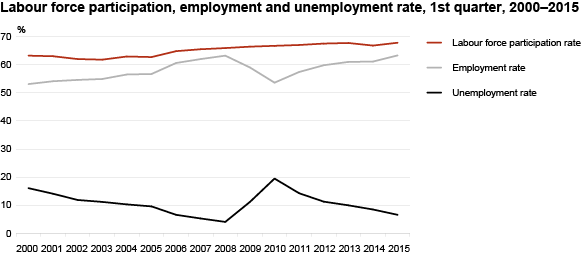Working-age people are increasingly more active in the labour market
In the 1st quarter of 2015, the unemployment rate increased by 0.3 percentage points compared to the fourth quarter of 2014. Hence, the growth was not very remarkable and can largely be explained by seasonal effects – several economic activities require less labour force in the winter months. Compared to the 1st quarter of 2015, however, unemployment decreased significantly in the 1st quarter of this year. The estimated number of unemployed persons decreased from 57,000 to 44,000 and the unemployment rate from 8.5% to 6.6%.
Compared to the decrease of the unemployment rate, the employment rate of the population aged 15–74 showed a similar level of growth – from 61.1% in the 1st quarter of 2014 to 63.3% in the 1st quarter of 2015. The estimated number of employed persons in the 1st quarter of 2015 was 623,000. Seasonal effects influence the employment rate even more than the unemployment rate – although compared to the 1st quarter of the previous year there were more employed persons, then compared to the rest of the quarters of 2014 there were fewer employed persons in the 1st quarter of 2015.
Recent years have shown a decrease in the number of active persons in the labour market, mainly due to population decline and the smaller birth cohorts reaching working age. Still, the number of economically active persons was slightly greater in 1st quarter of 2015 than in the same quarter of the previous year, and the labour force participation rate of the population aged 15–74 reached 67.8%. The biggest contribution to the increase in the labour participation rate was made by the decrease in the number of inactive persons by 12,500.
Compared with the 1st quarters of the previous years, the labour force participation rate (i.e. the share of the labour force among the population aged 15–74) in the 1st quarter of 2015 was at the highest level of the last 15 years. The increased economic activity of the working-age population has been strongly influenced by the greater labour force participation of the elderly but also by the bigger generation of the Singing Revolution having entered the labour market.
Thus, compared with the same quarter of the previous year, the developments in unemployment and employment have been positive regardless of sex, age or ethnicity.
In the 1st quarter, the employment rate of males was 67% and that of females 60%. Compared to the 1st quarter of 2014, the indicator increased slightly more for females than for men. Usually the employment gap between males and females has ranged between 5–10 percentage points with the exception of the 1st quarter of 2010 when the employment rate of females exceeded that of males by more than 10 percentage points. In the following years, the unemployment gap between males and females in the first quarter has been approximately 2 percentage points. The 1st quarter of 2015 was no exception: the unemployment rate of males was then 7.6% and that of females 5.6%.
By age group, young people aged 15–24 had the lowest employment rate and the highest unemployment rate in the 1st quarter of 2015. Compared to the 1st quarter of the previous year, the unemployment rate of young people fell to 13.8% in the 1st quarter of 2015. However, it still needs to be emphasised in relation to the lowest employment rate of young people that most of them are still studying and do not participate in the labour market.
In the 1st quarter of 2015, the unemployment rate of Estonians was 5.8% and that of non-Estonians 8.6%. The previous time that the unemployment rate of non-Estonians was below 10% was in the 3rd quarter of 2008 when the economic crisis and its implications for the labour market were still starting to emerge.The unemployment rate is the share of the unemployed in the labour force (the sum of employed and unemployed persons). The employment rate is the share of the employed in the working-age population (aged 15–74). The labour force participation rate shows the share of the labour force in the population aged 15–74. The estimates are based on the data of the Labour Force Survey.
Statistics Estonia has been conducting the Labour Force Survey since 1995 and every quarter 5,000 persons participate in the survey. The Labour Force Survey is carried out by statistical organisations in all the European Union Member States on the basis of a harmonised methodology.